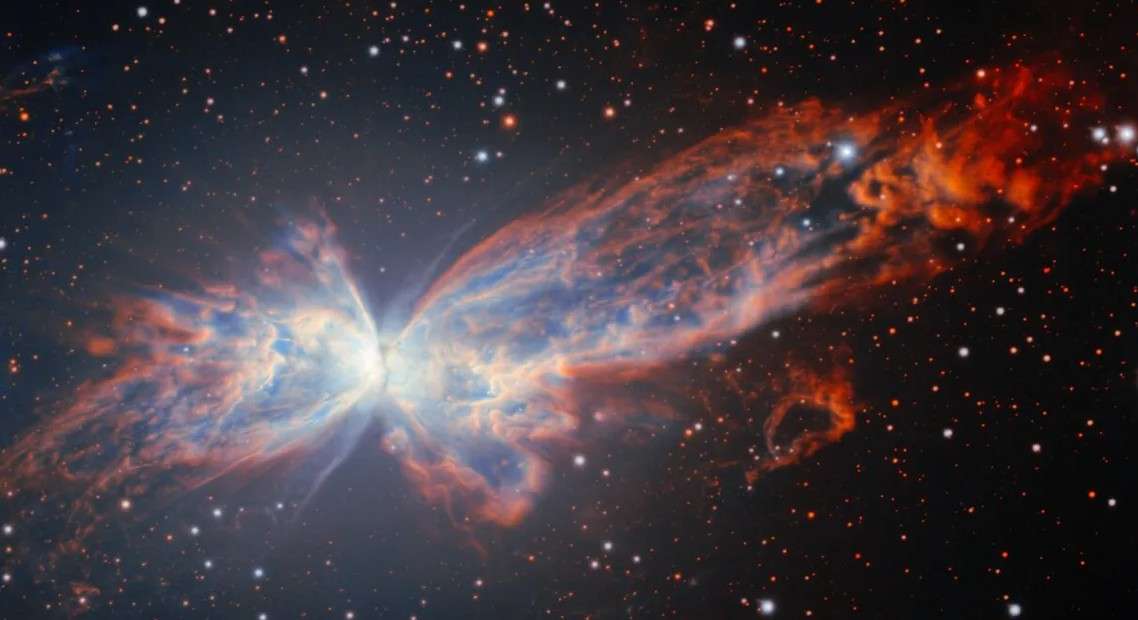The Butterfly Nebula Gemini South image is one of the most breathtaking astronomical visuals released this year. As the Gemini South telescope celebrates its 25th anniversary, astronomers unveiled a spectacular new look at this iconic nebula. You can explore more scientific discoveries in Pakistan on our Science & Technology section.
What Makes the Butterfly Nebula Special?
Also known as NGC 6302, the Butterfly Nebula lies in the constellation Scorpius. Though its exact distance remains uncertain, scientists estimate it is located 2,500–3,800 light-years away.
At the nebula’s center is an incredibly hot white dwarf, reaching a temperature of 250,000°C (450,000°F). This white dwarf was once a star slightly larger than our sun. As it neared the end of its life, it expanded into a red giant and eventually shed its outer layers, creating the glowing nebula we see today.
Learn more about fascinating cosmic events in our Space News category.
How the Nebula’s Wings Formed
As the star shed material, slower-moving gas formed a dark belt across the nebula’s center, giving shape to the “body” of the butterfly. Later, high-velocity outflows blasted in opposite directions, carving out the nebula’s striking wings.
Radiation from the dying star heated the surrounding material to 20,000°C (36,000°F), ionizing the gas. Red in the new image reveals ionized hydrogen, while blue highlights ionized oxygen.
Our sun will undergo a similar transformation in about 5 billion years, becoming a white dwarf surrounded by its own planetary nebula.
For more stories like this, visit PukaarPakistan’s Science Features.
Gemini South: Celebrating 25 Years of Discovery
The new Butterfly Nebula image commemorates the 25th anniversary of the Gemini South telescope, located in the Chilean Andes. This powerful 8.1-meter telescope is part of the International Gemini Observatory, which also includes its twin, Gemini North, in Hawaii.
The observatory is operated by the National Science Foundation’s NOIRLab, with support from Brazil, Canada, Chile, and the United Kingdom. The Butterfly Nebula was chosen as the anniversary image by Chilean students through the Gemini First Light Anniversary Image Contest.
The Vision Behind the Gemini Observatory
Astronomer Fred Gillett envisioned two technologically advanced telescopes—one in each hemisphere—to enable near-infrared surveys and adaptive optics imaging across the entire sky.
First light for Gemini North occurred in June 1999, followed by Gemini South in November 2000. After Gillett’s death, Gemini North was renamed the Frederick C. Gillett Gemini Telescope in his honor.
Stay updated with the latest international science news on our World Science category.
Conclusion: A Stunning Cosmic Masterpiece
This new Butterfly Nebula Gemini South image showcases not only the beauty of cosmic evolution but also the remarkable advancements in modern astronomy. It highlights how dying stars transform into breathtaking nebulae, enriching our understanding of space.
Call to Action
For more astronomy updates, scientific insights, and space-related news tailored for Pakistan, explore the Science & Technology category on PukaarPakistan.


